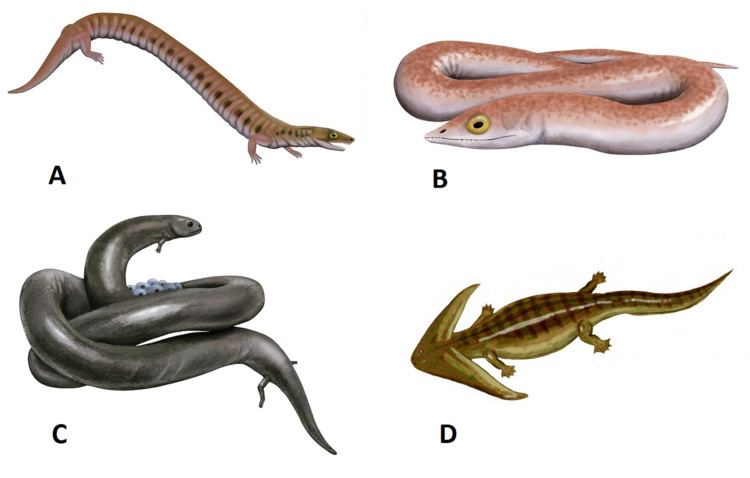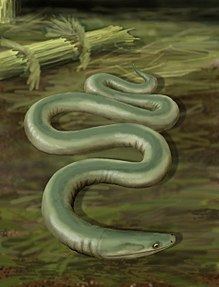Rank Subclass | Phylum Chordata Higher classification Amphibians | |
 | ||
Similar | ||
Lepospondyli
Lepospondyli is a diverse taxon of Paleozoic tetrapods (four-limbed vertebrates). It, along with its presumed daughter clade Lissamphibia, and Amphibia proper, are the primary taxa that make up the vertebrate group Batrachomorpha. With the exception of one late-surviving lepospondyl from the Late Permian of Morocco (Diplocaulus minumus), lepospondyls lived from the Early Carboniferous (Mississippian) to the Early Permian and were geographically restricted to what is now Europe and North America. Five major groups of lepospondyls are known: Adelospondyli; Aïstopoda; Lysorophia; Microsauria; and Nectridea. Lepospondyls have a diverse range of body forms and include species with newt-like, eel- or snake-like, and lizard-like forms. Various species were aquatic, semiaquatic, or terrestrial. None were large (the biggest genus, the diplocaulid Diplocaulus, reached a meter in length, but most were much smaller), and they are assumed to have lived in specialized ecological niches not taken by the more numerous temnospondyl amphibians that coexisted with them in the Paleozoic. Lepospondyli was named in 1888 by Karl Alfred von Zittel, who coined the name to include some tetrapods from the Paleozoic, that shared some specific characteristics in the notochord and teeth.
Contents

Description

All lepospondyls are characterised by having simple, spool-shaped vertebrae that did not ossify from cartilage, but rather grew as bony cylinders around the notochord. In addition, the upper portion of the vertebra, the neural arch, is usually fused to the centrum (the main body of the vertebra).
Classification

The position of the Lepospondyli within the Tetrapoda is uncertain because the earliest lepospondyls were already highly specialized when they first appeared in the fossil record. Some lepospondyls were once thought to be related or perhaps ancestral to modern salamanders (Urodela), but not the other modern amphibians. This view is no longer held and all modern amphibians (frogs, salamanders, and caecilians) are now grouped within the clade Lissamphibia. For a long time, the Lepospondyli were considered one of the three subclasses of Amphibia, along with the Lissamphibia and the Labyrinthodontia. Lepospondyls are now thought to be related or ancestral to modern amphibians or to Amniota (the clade containing reptiles and mammals).

Another hypothesis is that they are an artificial (polyphyletic) grouping with some members closely related to extinct stem tetrapod groups and others more closely related to modern amphibians.
Interrelationships
Five main groups of lepospondyls are often recognized: Microsauria, a superficially lizard- or salamander-like and species-rich group; Lysorophia, a group with elongated bodies and very small limbs; Aïstopoda, a group of limbless, extremely elongated snake-like forms; Adelospondyli, a group of presumably aquatic forms that resemble aïstopods, but have more solidly built skulls; and Nectridea, another diverse group that includes terrestrial and aquatic newt-like forms. Microsauria is currently considered paraphyletic; rather than being a monophyletic group, it probably represents an evolutionary grade of basal ("primitive") lepospondyls. Nectridea is probably also paraphyletic, consisting of a range of more derived lepospondyls. The name Holospondyli has been proposed for a clade including aïstopods, nectrideans, and possibly adelospondyls, although not all recent phylogenetic analyses support the grouping. The following cladogram, simplified, is after an analysis of stem amniotes presented by Ruta et al. in 2003:
Position within Tetrapoda
The "lepospondyl hypothesis" of modern amphibian origins proposes that lissamphibians are monophyletic (that is, they form their own clade) and that they evolved from lepospondyl ancestors. Two alternatives are the "temnospondyl hypothesis" in which lissamphibians originated within Temnospondyli and the "polyphyly hypothesis" in which caecilians originated from lepospondyls and frogs and salamanders (collectively grouped within Batrachia) evolved from temnospondyls. Of the three hypotheses, the temnospondyl hypothesis is currently the most widely accepted among researchers. Strong support for this relationship comes from a suite of anatomical features shared between lissamphibians and a group of Paleozoic temnospondyls called dissorophoids. Under this hypothesis Lepospondyli falls outside crown group Tetrapoda (the smallest clade containing all living tetrapods, i.e. the smallest clade containing Lissamphibia and Amniota), and is instead part of the tetrapod stem (defined as all tetrapods outside the crown group). However, some phylogenetic analyses continue to find support for the lepospondyl hypothesis. The analysis of Vallin and Laurin (2004) found lissamphibians to be most closely related to lysorophians, followed by microsaurs. Pawley (2006) also found lysorophians to be the closest relatives of lissamphibians, but found aïstopods and adelogyrinids rather than microsaurs to be the second most closely related groups. Marjanović (2010) found holospondyls to be the most closely related group to lissamphibians, followed by lysorophians. Under this hypothesis, lepospondyls would be crown tetrapods and temnospondyls would be stem tetrapods.
Below is a cladogram from Ruta et al. (2003) that supports the "temnospondyl hypothesis", showing the position of Lepospondyli within crown group Tetrapoda:
